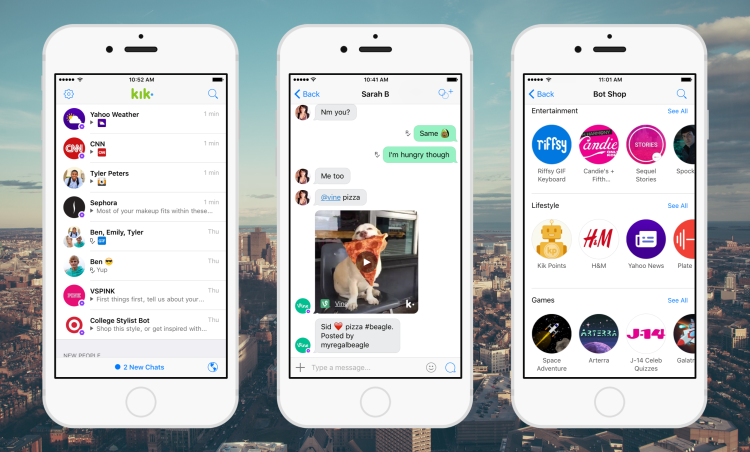The Bot Shop, where users of the chat app Kik go to get featured bots, recently surpassed 110 bots, the chat app announced today. And you wouldn’t know it by visiting the Bot Shop, but more than 20,000 bots have been made for the Kik platform.
That means roughly 1,100 bots have been created every week since April 5, when the platform opened for developers and other people to make their own bots.
Among the 110 or so bots featured in the bot shop are brand names like Funny or Die, CNN, and Victoria’s Secret.
To make it into the Bot Shop, developers must follow a submission process and show that their bots meet a high quality standard, a company spokesperson said. Bots that have yet to receive certification from Kik are limited to interacting with 50 users at a time and can only be discovered when shared by the creator, friends, or fans.
Bots made on Kik thus far run the gamut from gaming to sports to fashion and advice, much like variations seen at the emergence of the app ecosystem years ago, said President of Kik Services Josh Jacobs.
“The category that’s sort of nearest and dearest to my heart are the early stage startups that are smaller — three, four, five-people companies that have a great idea for a piece of technology, and, because of their age and their experience with chat, see this as the logical platform for them to start on,” Jacobs said.
Among other notable things announced about the emerging Kik bot ecosystem Wednesday:
- Kik users ages 13-19 are responsible for 60 percent of bot interaction
- 1.8 billion messages have been exchanged with bots
- Bot users are about 30 percent more likely to spend time chatting on Kik than non-bot users
- Kik bot usage skews female
- Roughly 80 percent of Kik bot usage thus far has been in the United States, Canada, and the United Kingdom
- H&M and Sephora’s bots have some of the highest active engagement rates, a metric Kik created for itself in early 2016.
Since major chat apps began to open their platforms up earlier this year, Kik and others have found themselves in the midst of an “arms race” to enhance their platforms and attract businesses and bot makers, Jacobs said.
Skype, Slack, Facebook Messenger, and other popular chat apps have made significant functionality changes since opening their platforms in late 2015 or early 2016.
Last month, Kik added the ability to invite friends to try a bot with a simple @ mention of a username. Zurvival, the zombie invasion game that was the first to allow invites — and the first bot to implement invites — now gets 20 percent of its new subscribers from the feature.
“Specifically as a developer, the cool thing that’s happening right now is this is very much an active arms race around platform, and we’re not the only people who are continuing to ship new updates to the platform,” Jacobs said. “I think one of my arguments, certainly to developers, is that — if you look at the things that we’re doing — we’re being incredibly responsive to their needs, not just to build great software but to build businesses there.”
One of the biggest lessons learned from the mobile chat platform WeChat, which helps shape the Kik platform, is that businesses can have fun and build relationships with customers in chat. But making those conversations happen is in part reliant upon a critical mass of consumers. (WeChat parent company Tencent is an investor in Kik and a partner.)
“I think what we’ve really taken away from that, first and foremost, is make it open, make it easy for people to get started and get set up,” Jacobs said. “Really, what we’re trying to do is make this as easy as publishing a web page.”
The other key, according to Jacobs: Work with people who are building tools, not just people who are building bots, and focus on people and companies that can be force multipliers and “will do their work to make it possible for hundreds of thousands of other people to build bots.”
Kik’s force multipliers include companies like Sequel, which beat Google to the punch making “me” bots that can mimic your personality; Outbrain, which makes bots for content creators like CNN; and Imperson, which is building a “WordPress for bots.”
Update 10:40 a.m. Aug. 3: The original version of this story stated that 19,000 bots have been made for the Kik platform but shortly after publishing this story Kik stated that the number of bots made for Kik surpassed 20,000.
VentureBeat's mission is to be a digital town square for technical decision-makers to gain knowledge about transformative enterprise technology and transact. Learn More

